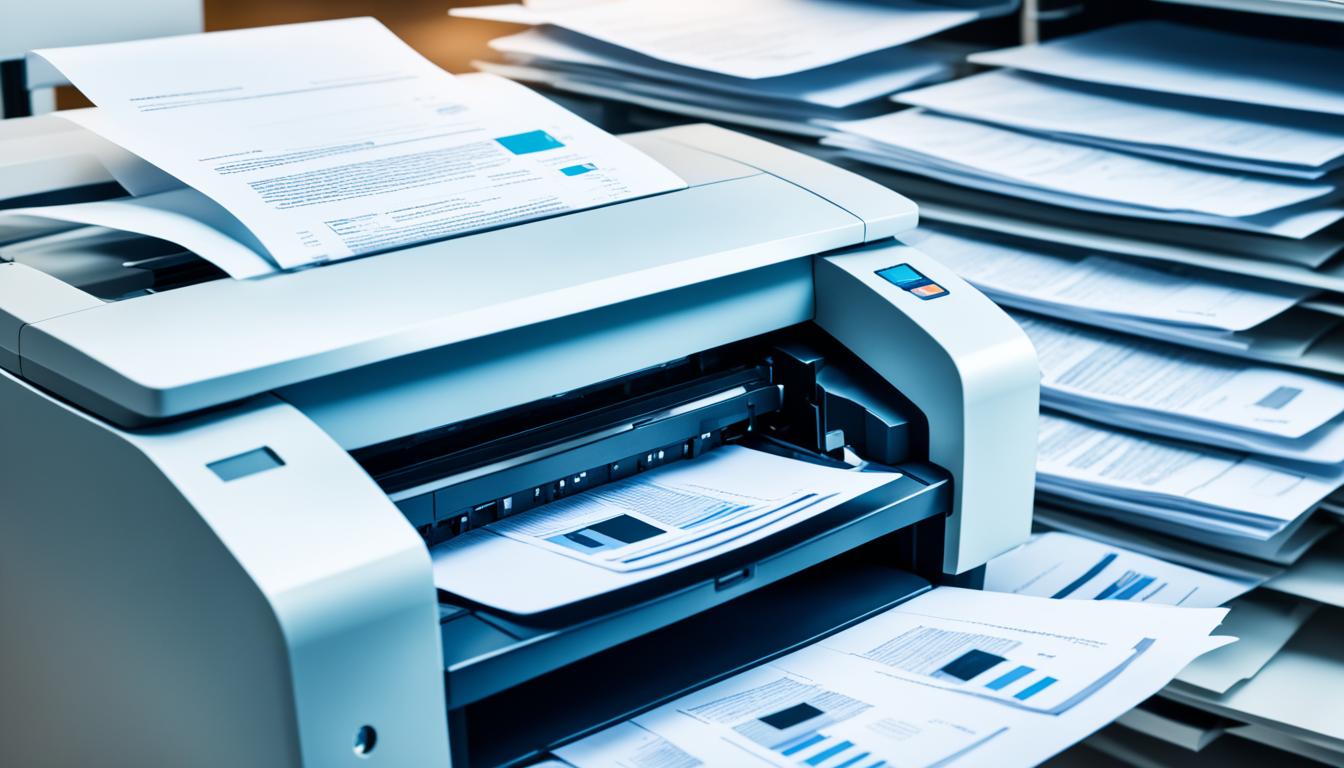In today's digital age, concerns about privacy and security are increasing. Many people wonder if their printing activities are being monitored. This article explores whether printers have the capability to track and monitor print jobs.
Key Takeaways:
- Printers have the capability to track print jobs based on the type of device and network setup.
- Print monitoring can be categorized into quantity tracking and content monitoring.
- Companies monitor print usage for budget management and security compliance.
- Using personal printers or encrypting sensitive documents can help protect privacy at the workplace.
- Companies should communicate print monitoring policies to ensure transparency and avoid privacy concerns.
Print Device Network Capabilities
When it comes to the ability of printers to track print jobs, the level of monitoring varies based on the device type and network setup. While most modern copiers, especially those connected to dedicated print servers, have robust monitoring capabilities, smaller companies with older devices may have limited tracking functionalities. Larger companies that work with managed print providers can leverage advanced tracking features to monitor usage trends and generate comprehensive reports.
Hybrid offices with remote employees can also take advantage of the device network capabilities to track print jobs over the internet. This enables organizations to maintain visibility and control over printing activities regardless of the employees' location.
“The device network capabilities of modern printers provide valuable insights into printing activities and usage patterns, allowing businesses to optimize their print environment and enhance cost management.”
Print Device Network Capabilities
| Device Type | Network Setup | Tracking Capabilities |
|---|---|---|
| Modern Copiers | Dedicated Print Servers | Extensive monitoring capabilities |
| Smaller Companies | Older Devices | Limited tracking functionalities |
| Larger Companies | Managed Print Providers | Advanced tracking features and reporting |
| Hybrid Offices | Remote Employees | Tracking print jobs over the internet |
Understanding the device network capabilities empowers organizations to efficiently manage their printing environment, control costs, and ensure compliance with printing policies.
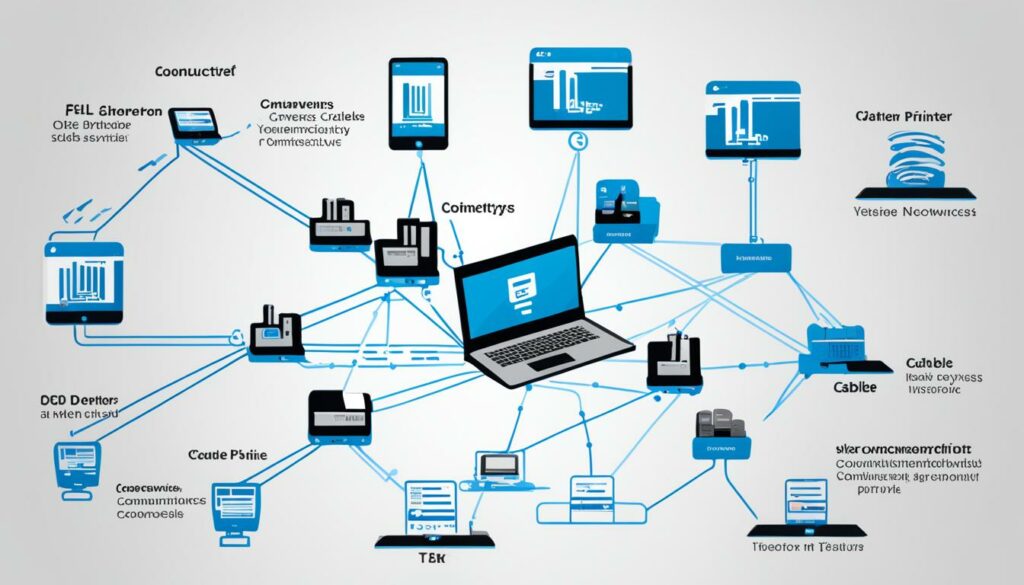
Types of Print Monitoring
Print monitoring plays a crucial role in understanding printing activities within an organization. It can be categorized into two main types: quantity tracking and content monitoring.
Quantity Tracking
Quantity tracking involves monitoring various aspects of print job volume to gain valuable insights into printing patterns and resource utilization. This type of monitoring helps organizations optimize their printing processes and manage costs effectively. Here are some key elements of quantity tracking:
- Number of pages: Tracking the number of pages printed helps assess the overall print volume and identify potential areas for improvement.
- Color usage: Monitoring color usage provides insights into the extent to which color printing is utilized and can help organizations optimize costs by encouraging grayscale printing when appropriate.
- Device usage patterns: Analyzing device usage patterns helps organizations identify high-demand areas and optimize device placement for improved efficiency.
By actively tracking these aspects, organizations can make informed decisions to optimize print resources and reduce unnecessary wastage.
Content Monitoring
Content monitoring focuses on evaluating the actual content of printed documents, often driven by security and compliance requirements. This type of monitoring ensures sensitive information is protected and organizational policies are adhered to. Some industries, such as finance and healthcare, have stricter regulations, making content monitoring particularly critical. Here are some key considerations in content monitoring:
“Effective content monitoring helps organizations protect sensitive information, maintain compliance, and prevent potential security breaches.” – IT Security Expert
- Security: Monitoring printed content helps organizations detect any unauthorized or suspicious document printing activities, mitigating the risk of data leaks or breaches.
- Compliance: Content monitoring ensures adherence to industry-specific regulations, ensuring organizations avoid penalties and maintain a secure and compliant environment.
- Policy enforcement: By monitoring printed content, organizations can enforce policies related to the acceptable usage of printing resources and prevent any misuse.
Monitoring in Action
Let's take a look at an example of how print monitoring benefits a healthcare organization:
| Monitoring Aspect | Benefits |
|---|---|
| Quantity Tracking | Identifying high print volumes and areas of excessive color usage allows the organization to implement cost-saving measures and optimize resource allocation. |
| Content Monitoring | Ensuring compliance with patient privacy regulations by monitoring sensitive document printing, which prevents unauthorized access to confidential information. |
By combining quantity tracking and content monitoring, organizations can achieve efficient printing practices while safeguarding sensitive information.
The printer usage monitoring plays a significant role in budget management for many companies. By closely monitoring print volume and usage patterns, employers can effectively manage print costs and identify any instances of excessive printing. This data provides valuable insights that aid in budget planning for future print expenses, as well as optimizing printer usage to minimize unnecessary costs.
Tracking print usage allows companies to have a clear understanding of their printing needs and patterns, enabling them to make informed decisions regarding print resources and expenditures. By analyzing the data collected through print usage monitoring, companies can identify areas where print volumes are high and implement strategies to reduce unnecessary printing. This includes implementing print quotas, promoting duplex printing, and encouraging digital alternatives when feasible.
Additionally, print usage monitoring facilitates the identification of users or departments that may be responsible for excessive printing. By pinpointing these areas, companies can address the issue directly with the individuals involved, provide necessary guidance on print policies, and further enforce responsible printing behavior.
Print usage monitoring also helps companies identify potential cost-saving opportunities. By analyzing the data, companies can determine the most cost-effective printers to use for specific types of print jobs, as well as identify alternatives that can potentially reduce print costs without compromising productivity or quality.
By implementing print usage monitoring, companies can gain better visibility and control over their print-related expenses. This proactive approach to budget management ensures that print resources are utilized efficiently and cost-effectively, resulting in overall savings for the organization.
Benefits of Print Usage Monitoring for Budget Management:
- Optimizes print-related expenses
- Identifies areas of excessive printing
- Enforces responsible printing behavior
- Identifies cost-saving opportunities
- Provides better visibility and control over print-related expenses
“Print usage monitoring allows companies to gain better control over their print costs and optimize their budget management.” – Print Management Expert
By utilizing print usage monitoring, companies can effectively manage their budgets while still meeting their printing needs. This approach empowers organizations to make data-driven decisions, reduce unnecessary printing, and promote responsible printing practices.
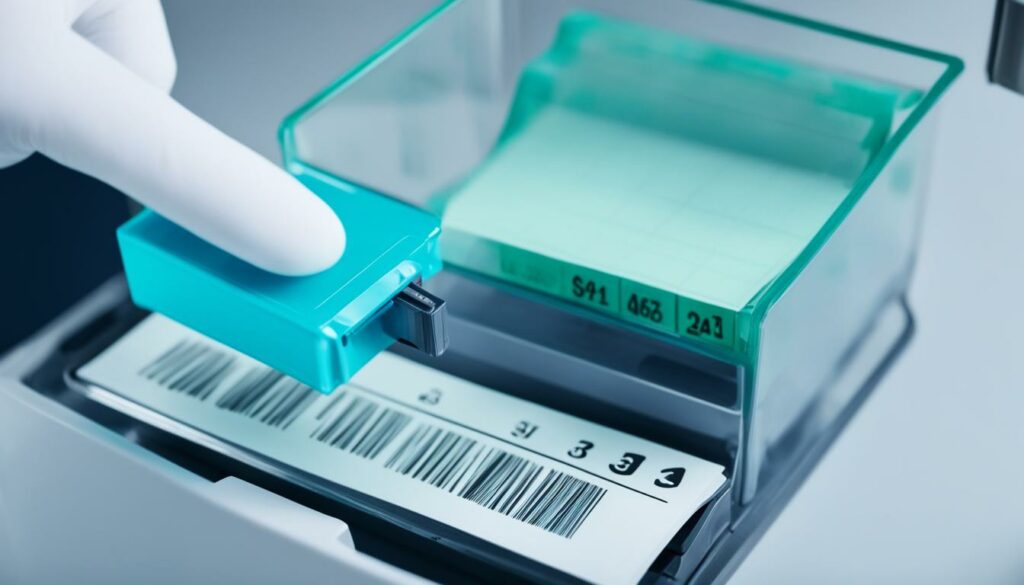
Print Monitoring for Security and Compliance Measures
In industries where confidentiality and compliance are critical, employers closely monitor printed content. Print monitoring helps prevent security breaches and ensures compliance with regulations. If a print job violates company policies, tracking the source of the print job becomes crucial in investigations.
Companies implement print monitoring systems to safeguard sensitive information and prevent unauthorized access. By monitoring print jobs, employers can identify potential security breaches and take proactive measures to address them. This not only protects the company's data but also maintains trust and confidence among clients and stakeholders.
Print monitoring for compliance measures goes beyond just security concerns. Many industries have strict regulations regarding sensitive data, and failure to comply can result in severe penalties and reputational damage. By monitoring print jobs, companies can ensure that all documents adhere to these compliance measures, safeguarding confidential information and maintaining legal compliance.
“Print monitoring helps maintain a secure printing environment by preventing security breaches and ensuring compliance with regulations.”
Moreover, print monitoring allows companies to track and audit printed materials, providing accountability for all print-related activities. This is particularly crucial in sectors that handle sensitive customer information, such as healthcare and finance, where compliance with data protection laws and regulations is of utmost importance.
The Benefits of Print Monitoring for Security and Compliance
Effective print monitoring offers several benefits for companies striving to maintain security and compliance:
- Identify and prevent security breaches: By monitoring print jobs, companies can identify unusual or unauthorized print activities, helping them detect and mitigate potential security breaches.
- Ensure compliance with regulations: Print monitoring enables companies to enforce compliance measures by tracking and auditing printed materials, ensuring that all documents adhere to legal requirements.
- Protect sensitive data: By closely monitoring printed content, companies can protect sensitive information from being mishandled or accessed by unauthorized individuals.
- Prevent data leaks: Print monitoring helps identify and address any internal or external sources of data leaks, reducing the risk of confidential information falling into the wrong hands.
Implementing print monitoring measures is a proactive approach to maintaining security and compliance. By investing in print monitoring systems, companies can establish a robust framework for protecting sensitive data and adhering to industry regulations.
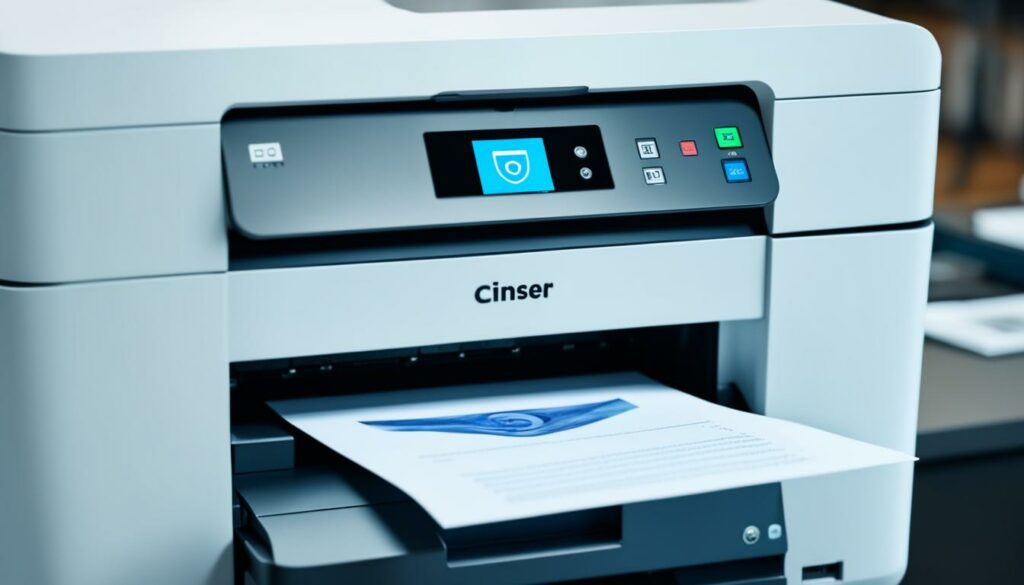
Print monitoring plays a crucial role in safeguarding company and customer data, as well as maintaining compliance with industry regulations. It serves as a proactive measure to prevent security breaches, protect sensitive information, and ensure legal compliance. By tracking and monitoring print jobs, companies can maintain a secure printing environment and mitigate potential risks.
Protecting Your Privacy at the Workplace
When it comes to workplace printing, protecting your privacy is essential. Luckily, there are measures you can take to ensure your sensitive information remains secure. Here are two options to consider:
- Use a Personal Printer: If possible, opt for a personal printer that is not connected to the company network. By having your own device, you can maintain more control over your print jobs and reduce the risk of any monitoring or tracking.
- Encrypt or Password-Protect Documents: For documents that contain sensitive information, consider encrypting them or adding password protection before sending them to the printer. This extra layer of security ensures that only authorized individuals can access and view the content.
While these measures can help protect your privacy, it's essential to note that not all industries may allow such practices due to strict compliance measures. Be aware of your company's policies and consult with your IT department if needed.
Expert Recommendation:
“Taking steps to safeguard your privacy at the workplace is crucial, especially when it comes to printing sensitive documents. By using a personal printer or encrypting your files, you can significantly reduce the risk of unauthorized access and maintain the confidentiality of your information.” – Jane Smith, IT Security Expert
By being proactive in protecting your privacy, you can ensure a greater sense of security when printing at work.
| Methods to Protect Privacy at the Workplace | Feasibility |
|---|---|
| Using a personal printer | Feasible if allowed by company policies |
| Encrypting or password-protecting documents | Feasible with most printers and document formats |

Companies' Responsibility in Monitoring
When it comes to print monitoring, companies hold a significant responsibility in ensuring transparency and protecting the privacy of their employees. By clearly communicating their printing policies, companies can establish a culture of trust and openness.
Printing policies should outline what is and is not acceptable to print on office hardware, setting clear guidelines for employees to follow. This promotes responsible use of resources and helps prevent any misuse or unauthorized printing activities.
Transparency is key in maintaining a positive working environment. Companies should make their monitoring practices known to employees, explaining the reasons behind such measures and how they contribute to the overall functioning of the organization.
Employees, in turn, should familiarize themselves with the company's printing policy to understand the level of monitoring in place. This knowledge enables them to align their print behaviors with the company's expectations, avoiding any potential privacy concerns.
“Transparency and clear communication are vital components of responsible print monitoring. Companies need to ensure that employees are aware of the policies in place, promoting a culture of trust and accountability.”
To foster transparency and responsible printing practices, companies can consider the following:
- Hold informational sessions or workshops to educate employees about the importance of print monitoring and the impact it has on the organization.
- Implement a system of periodic review and revision of printing policies to adapt to changing technology and privacy regulations.
- Encourage feedback and open dialogue regarding print monitoring, allowing employees to voice concerns or suggest improvements.
By actively engaging both employers and employees in the conversation, companies can strike a balance between monitoring transparency and privacy, creating a harmonious and productive work environment.
Examples of Key Elements in Printing Policies
| Element | Description |
|---|---|
| Authorized content | List of acceptable materials for printing, ensuring compliance with legal and ethical standards. |
| Usage guidelines | Instructions on printer usage, including print volume limits and required document formatting. |
| Confidentiality measures | Guidelines on handling sensitive information, emphasizing protocols to prevent data breaches. |
| Maintenance procedures | Instructions on printer maintenance, encouraging employees to report any malfunctions or issues promptly. |
Implementing comprehensive printing policies not only protects company assets and information but also ensures that employees understand their responsibilities in maintaining a secure and efficient printing environment.
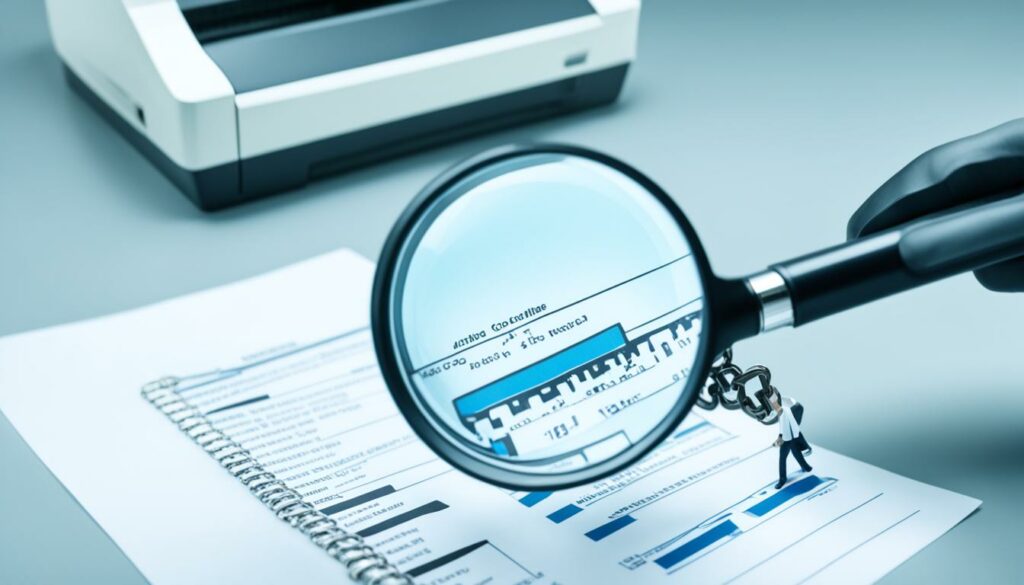
Machine Identification Code: The Forensic Tracking Technology
Modern color inkjet and laser printers come equipped with a powerful tool that goes unnoticed by most users – the Machine Identification Code (MIC). This innovative technology acts as a discreet digital watermark on every printed document, containing valuable information such as the printer's serial number and the exact date and time of printing.
The Machine Identification Code (MIC) is virtually invisible to the naked eye, making it an ideal forensic tracking tool. In the event of a document being used in an unauthorized or illegal manner, this code can be crucial in determining the origin of the printed material.
To better understand the significance of the Machine Identification Code, let's take a closer look at an example:
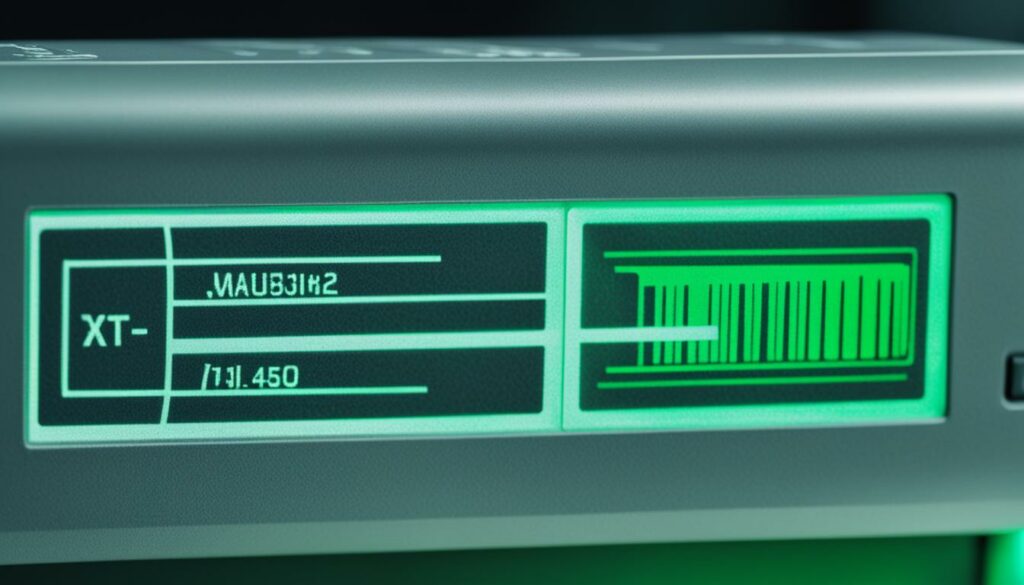
In the image above, the hidden code is represented by a matrix of yellow dots, meticulously arranged in an 8 × 16 format. These dots, each measuring about 1/10th millimeter in diameter, play a vital role in forensic investigations, leaving a unique and traceable mark on every printed document.
Law enforcement agencies, legal professionals, and corporate organizations have utilized the Machine Identification Code technology to their advantage, as it provides valuable evidence that could potentially solve criminal cases or identify document leaks.
Table: Pros and cons of Machine Identification Code in forensic tracking
| Pros | Cons |
|---|---|
| Powerful forensic tracking tool | Potential privacy concerns |
| Aids in criminal investigations | Possible chilling effect on freedom of expression |
| Assists in identifying document leaks | Requires appropriate handling and interpreting expertise |
The Machine Identification Code undoubtedly offers valuable insights in forensic tracking, contributing to the accountability and security of printed materials. However, concerns regarding privacy and freedom of expression must also be weighed against the benefits of this technology.
In the next section, we will delve deeper into the technical aspects of the Machine Identification Code and explore its potential implications for document identification and tracking.
Technical Side of Machine Identification Code
The Machine Identification Code, also known as the yellow tracking dots, plays a crucial role in document identification and tracking. Represented by a matrix of yellow dots, each about 1/10th millimeter in diameter, and arranged in an 8 × 16 format, these dots are intentionally added by printer manufacturers as a covert identification feature.
Under normal circumstances, these yellow tracking dots are invisible to the naked eye. They can only be detected and visualized under specific lighting conditions that heighten their visibility. The purpose behind this covert technology is to embed essential information within the printed document.
The Machine Identification Code contains key details, including the serial number of the printer, making it possible to trace the specific device used for printing. Furthermore, it also includes metadata about the print job itself, such as the date and time of printing. This information aids in the identification, tracking, and monitoring of documents.
![]()
Privacy Implications of Machine Identification Code
The use of Machine Identification Code in printers raises significant concerns regarding privacy implications. These codes have the potential to track individuals who print specific documents, which can give rise to various privacy and security risks. The identification technology embedded in printers allows for tracking possibilities that may be misused or have a chilling effect on freedom of expression. While the US government has not officially commented on the use of these codes, it is crucial for users to be aware of their existence and understand the potential implications they pose.
Machine Identification Codes have the potential to be used for tracking and monitoring print jobs, presenting a challenge to privacy in the workplace. With the increasing connectivity of printers and the advancement of identification technology, it is essential for individuals and organizations to assess the privacy risks associated with these tracking capabilities.
By utilizing Machine Identification Codes, employers can track the source of specific documents, potentially compromising the privacy of employees. This tracking technology enables the identification of individuals based on their print history, which may infringe upon personal privacy rights. It is important for individuals to weigh the convenience of efficient print management against the potential privacy implications when using printers equipped with identification technology.
“While the intention behind Machine Identification Codes is to aid in forensic investigations and document tracking, the inherent tracking capabilities of these codes may have unintended privacy consequences.”
The privacy concerns associated with Machine Identification Codes highlight the need for transparency and accountability in the use of identification technology in printers. Organizations should establish clear policies and procedures regarding the collection, storage, and use of print job data to address potential privacy risks effectively.
Protecting Privacy: Best Practices
To mitigate the privacy implications of Machine Identification Codes and identification technology in printers, consider the following best practices:
- 1. Implement Privacy-Conscious Printing Policies: Organizations should develop and communicate clear printing policies that address the privacy concerns associated with tracking technologies. These policies should outline the specific uses of print job data, how long it is retained, and the measures in place to protect sensitive information.
- 2. Understand Device Capabilities: Users should familiarize themselves with the features and capabilities of their printers, including any tracking technologies that may be present. This knowledge will help individuals make informed decisions about document printing and the potential privacy risks involved.
- 3. Encrypt Sensitive Documents: To safeguard sensitive information, consider encrypting documents before sending them to print. Encryption can provide an extra layer of protection against unauthorized access or tracking.
By being mindful of privacy implications and following best practices, individuals and organizations can strike a balance between efficient print management and protecting personal privacy. It is essential to stay informed about the evolving landscape of identification technology in printers and its impact on privacy for a secure and productive printing environment.
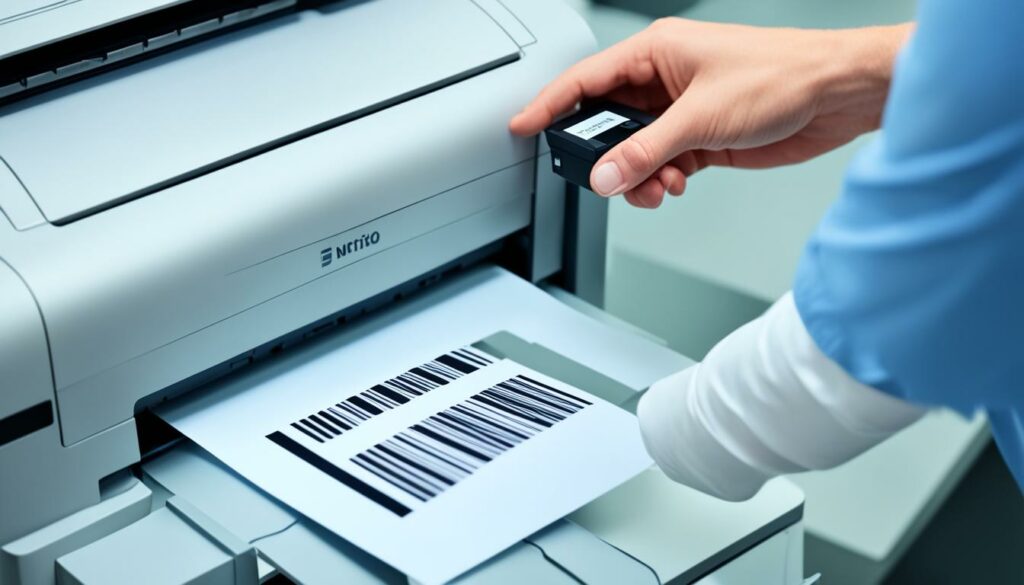
Conclusion
Printers have the capability to track print jobs, but the extent of monitoring depends on the company's technological capabilities and policies. Print monitoring is primarily done for budget management, security reasons, and compliance with regulations. It is important for individuals to be mindful of the potential privacy implications and take necessary precautions to protect their sensitive information when printing at work.
Throughout this article, we've explored the various aspects of printers tracking print jobs. We've discussed the different types of print monitoring, such as quantity tracking and content monitoring, and how companies use this data for budget management and security measures. We've also highlighted the importance of protecting privacy in the workplace and being aware of the machine identification code used for forensic tracking.
When it comes to print jobs, it's crucial to strike a balance between privacy concerns and workplace requirements. While printers do have the capability to track print jobs, individuals can take steps to protect their privacy. This includes using personal printers, encrypting sensitive documents, and familiarizing themselves with their company's printing policies.
Reputable Experts Recommend Being Mindful of Your Print Jobs
When it comes to printing, being aware of the potential tracking capabilities is essential. Reputable experts, including the Electronic Frontier Foundation, advocate for individuals to exercise caution with their print jobs. While employers may have valid reasons for monitoring printing activity, it is crucial to find a balance between privacy concerns and workplace requirements.
To create a secure and productive printing environment, it is vital to familiarize yourself with your company's print monitoring policies. Understanding what is acceptable to print on office hardware and adhering to the guidelines ensures transparency and mitigates privacy concerns. By being mindful of your print jobs and taking precautions to protect sensitive information, you can help maintain a secure workplace.
Reputable experts' recommendations emphasize the need for a proactive approach to mindful printing. Taking the time to encrypt or password-protect sensitive documents before printing, when feasible, enhances the security of your printed materials. Prioritizing privacy in your printing habits promotes a responsible and secure information management culture.
By following the advice of reputable experts, you can navigate the potential implications of print monitoring while fulfilling workplace requirements. Being mindful of your print jobs and adopting privacy-conscious practices contributes to a productive and secure printing environment.

I'm Morgan, the creator of VPNForMe — a site born from too many hours spent side-eyeing sketchy VPN reviews and buffering videos.
I wanted a place where people could get straight answers about privacy, streaming access, and which VPNs actually deliver — without the hype or tech jargon.

